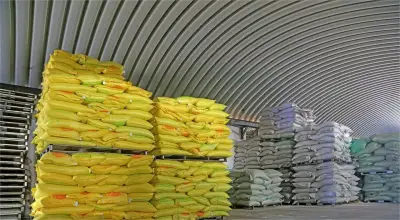NEWS

About urea
Urea is a common and widely used nitrogen-based fertilizer in agriculture. It is a white, crystalline solid with the chemical formula CO(NH2)2 and contains approximately 46% nitrogen. Urea is an organic compound made by combining ammonia and carbon dioxide. Here are some key points about urea fertilizer:
Nitrogen Content: Urea is valued as a nitrogen fertilizer because of its high nitrogen content. Nitrogen is a crucial nutrient for plant growth, and urea is a cost-effective source of this essential element.
Solubility: Urea is highly soluble in water, making it suitable for various application methods, including foliar spraying, drip irrigation, and soil application.
Application: Urea can be used for a wide range of crops, including cereals, vegetables, and fruits. It is often applied to provide a quick and efficient source of nitrogen to plants.
Slow Release: Urea can be converted into ammonium and nitrate forms by soil microorganisms through a process called hydrolysis. This slow-release nature can help provide a more sustained source of nitrogen to plants.
Volatilization: One drawback of urea is its susceptibility to nitrogen loss through ammonia volatilization, especially when not incorporated into the soil or when applied in alkaline conditions. This loss can be minimized by proper application techniques and timing.
Urea Formaldehyde: Urea can also be used in slow-release fertilizers when combined with formaldehyde to create a urea-formaldehyde fertilizer. This type of fertilizer releases nitrogen slowly over an extended period.
Granular and Prilled Forms: Urea is available in both granular and prilled (small spherical pellets) forms, allowing for flexibility in application methods.
Nutrient Balance: While urea provides an excellent source of nitrogen, it does not contain other essential nutrients like phosphorus and potassium. Therefore, it is often used in combination with other fertilizers to maintain a balanced nutrient profile for plants.
Handling Precautions: Urea can be irritating to the skin and eyes and can release ammonia gas when exposed to moisture. Proper safety precautions are necessary when handling urea.
Environmental Impact: Urea, like other nitrogen-based fertilizers, can contribute to environmental issues such as water pollution through runoff and the release of greenhouse gases like nitrous oxide. Therefore, it’s important to use urea and other fertilizers judiciously and in a manner that minimizes environmental impact.
Urea is an essential tool in modern agriculture, helping to boost crop yields and improve food production. However, its use should be part of a broader nutrient management plan to ensure sustainable and responsible agricultural practices.

About diammonium phosphate
The chemical composition of phosphate diamine in fertilizer is mainly (NH4)2HPO4; Index name Excellent product First Class product
Qualified product available phosphorus (%) 46-48 ≥42 ≥38
Water soluble phosphorus (%) ≥42 38 32
Total nitrogen (%) 16-18 ≥15…
Index Name Excellent product First-class product Qualified product Available Phosphorus 46484238 Water-soluble Phosphorus 423832 Total nitrogen 161815″
Diamine fertilizer is diammonium phosphate fertilizer, in which the nitrogen content is 18%, the phosphorus content is 46%, and the total nutrient is as high as 64%. Diamine fertilizer has the characteristics of low nitrogen, high phosphorus and no potassium, which is suitable for rice, wheat, corn, sweet potato and other crops, and is especially suitable for sugarcane, water chestnut and other nitrogenophilic and phosphorous crops.
Diammonium phosphate fertilizer contains what ingredients
Fertilizer components are nitrogen and phosphorus, fertilizer products generally contain 15-18% nitrogen, phosphorus 42-46%. Diammonium hydrogen phosphate (DAP) is a compound fertilizer containing two nutrients, nitrogen and phosphorus. Gray or dark gray particles, specific gravity 1.619, soluble in water, insoluble in ethanol. It has certain hygroscopic properties and is easy to decompose in humid air, volatilizing ammonia into ammonium dihydrogen phosphate. The aqueous solution is weakly alkaline, pH8.0. Product specifications :64%(N18:P2O546), 61%(N16:P2O545), 57%(N15:P2O542).
Function and application of diammonium fertilizer
The chemical properties of diammonium phosphate are alkaline, so it is an alkaline fertilizer. Diammonium phosphate is a high-concentration fast-available nitrogen and phosphorus compound fertilizer based on phosphorus, which is suitable for the vast majority of crops and is also suitable for use in various soils. It can be used in a wide range of applications and can be used as base fertilizer or topdressing.
Diammonium phosphate can be used to fertilize a variety of soil types in paddy field and dry land, suitable for rice, wheat, corn, sweet potato, peanut, rape, peanut and other crops, especially for sugarcane, water chestnuts and other hydrogen-loving and phosphorous crops. Diammonium phosphate can be combined with ammonium bicarbonate, urea, ammonium chloride, potassium chloride, ammonium nitrate and other fertilizers, and avoid mixed application with ammonium sulfate and superphosphate and other acidic fertilizers.

About compound fertilizer
The nitrogen, phosphorus and potassium content of high concentration compound fertilizer exceeds 40%, the nitrogen, phosphorus and potassium content of medium concentration compound fertilizer exceeds 30%, and the nitrogen, phosphorus and potassium content of low concentration compound fertilizer exceeds 25%.
High concentration compound fertilizer: nitrate nitrogen content is more than 1.5%, water-soluble phosphorus accounts for more than 60% of available phosphorus.
Medium concentration compound fertilizer: nitrate nitrogen content is more than 1.5%, water-soluble phosphorus accounts for more than 50% of available phosphorus.
Low concentration compound fertilizer: nitrate nitrogen content is more than 1.5%, water-soluble phosphorus accounts for more than 40% of available phosphorus.
First, high concentration compound fertilizer
1, the total nutrient content (pure nitrogen + phosphorus pentoxide + potassium oxide) more than 40%.
2, water-soluble phosphorus accounts for more than 60% of available phosphorus, nitrate nitrogen content is more than 1.5%, moisture content is less than 2%, and particles with particle size of 1-4.75mm (or 3.35-5.6mm) exceed 90%.
3. The chloride ion content of products not marked with chlorine is less than 3%, the chloride ion content of products marked with chlorine (low chlorine) is less than 15%, and the chloride ion content of products marked with chlorine (medium chlorine) is more than 30%.
4, effective calcium content more than 1%, effective magnesium content more than 1%, total sulfur content more than 2%, single trace element more than 0.02%.
Second, medium concentration compound fertilizer
1, the total nutrient content (pure nitrogen + phosphorus pentoxide + potassium oxide) more than 30%.
2, water-soluble phosphorus accounts for more than 50% of available phosphorus, nitrate nitrogen content is more than 1.5%, water content is less than 2.5%, and particles with a particle size of 1-4.75 mm (or 3.35-5.6 mm) exceed 90%.
3. The chloride ion content of products not marked with chlorine is less than 3%, the chloride ion content of products marked with chlorine (low chlorine) is less than 15%, and the chloride ion content of products marked with chlorine (medium chlorine) is more than 30%.
4, effective calcium content more than 1%, effective magnesium content more than 1%, total sulfur content more than 2%, single trace element more than 0.02%.
Third, low concentration compound fertilizer
1, the total nutrient content (pure nitrogen + phosphorus pentoxide + potassium oxide) more than 25%.
2, water-soluble phosphorus accounts for more than 40% of available phosphorus, nitrate nitrogen content is more than 1.5%, water content is less than 5%, and particles with a particle size of 1-4.75mm (or 3.35-5.6mm) exceed 90%.
3. The chloride ion content of products not marked with chlorine is less than 3%, the chloride ion content of products marked with chlorine (low chlorine) is less than 15%, and the chloride ion content of products marked with chlorine (medium chlorine) is more than 30%.
4, effective calcium content more than 1%, effective magnesium content more than 1%, total sulfur content more than 2%, single trace element more than 0.02%.
Compound fertilizer implementation standards?
First, the quality standard of compound fertilizer: 1, the total nitrogen and phosphorus content of nitrate phosphate fertilizer requires 36% to 40% (nitrogen is 20% to 27%, phosphorus is 11% to 13.5%). 2, the total content of mono-ammonium phosphate nitrogen and phosphorus requires 51% to 63% (nitrogen is 9% to 11%, phosphorus is 42% to 52%). 3, the total content of diammonium phosphate nitrogen and phosphorus is 51% to 64% (nitrogen is 13% to 18%, phosphorus is 38% to 46%). The quality standard of potassium dihydrogen phosphate for agricultural use is: 1, the content of first-class products should be ≥96.0%, the content of potassium should be ≥33.2%, and the moisture should be ≤4.0%. 2, qualified product content should be ≥92.0%, ** potassium content ≥31.8%, moisture ≤5.0%, pH between 4.3 and 4.7.
Potassium sulfate compound fertilizer what brand is best?
Red tetragonal potassium sulfate compound fertilizer is made of pure potassium sulfate raw materials, with abundant products and complete formula. Suitable for a variety of crops, often used in chlorine crops and economic fruit and vegetable crops, Common formula uses 45% (18-5-22), pure potassium sulfate double sulfur compound fertilizer containing nitrate nitrogen fertilizer 40% (21-7-12), balanced potassium sulfate compound fertilizer 51% (17-17-17), fruit and vegetable greenhouse special potassium sulfate compound fertilizer 40% (15-5-20), high tower type potassium sulfate compound fertilizer 45% (15-15-15) Figured.
Is Stanley 51% compound?
Your question is not very clear, 51% is the total nutrient? Stanley’s tower compound fertilizer has a maximum total nutrient content of 60%. The nitrogen content of urea is about 46%, and the fertilizer required should be determined according to different nutrient requirements.
